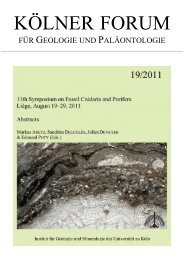Download (6Mb) - USP Electronic Research Repository - The ...
Download (6Mb) - USP Electronic Research Repository - The ...
Download (6Mb) - USP Electronic Research Repository - The ...
You also want an ePaper? Increase the reach of your titles
YUMPU automatically turns print PDFs into web optimized ePapers that Google loves.
Benthic Marine Algae of Rotuma Island<br />
Fijian Records<br />
Garbary et al. 1991: 253; South and Kasahara 1992: 54.<br />
Rotuman Distribution<br />
Maka Bay ("MAK151 <strong>USP</strong> S5: 7,863,864), Fapufa (<strong>USP</strong> S12: 8).<br />
Habitat and Remarks<br />
Growing entangled with Sargassum polycysturn in Maka Bay, seaward of the seagrass<br />
beds at about 0.6 m depth. Smaller plants found attached to coral, 0.5 m depth in a tidal pool<br />
at Fapufa, together with Padina tenuis.<br />
<strong>The</strong> Rotuman plants are in excellent accord with Okamura's description and habit of the<br />
Ponape species. North Atlantic species of the genus Dilophus have been transferred to<br />
Dictyota by Hornig et al. (1992), based on a lack of separating characters between members<br />
of the two genera. However, work on Pacific species of Dictyota and Dilophus is still in<br />
progress (Prud'homme van Reine, pers. comm.). While it is likely that Pacific members of<br />
the genus Dilophus should eventually be incorporated into Dictyota, until such time as the<br />
conspecificity of the two genera in the Pacific is confirmed the name Dilophus radicans is<br />
retained in the present treatment. Dilophus is also retained by Millar and Kraft (1994: 17) for<br />
Australian species of that genus.<br />
Lobophora J . Agardh 1894<br />
Lobophora variegata (Lamouroux) Womersley 1967: 22; Womersley and Bailey 1970:<br />
292; Tsuda 1972: 97, pl. 5, fig. 1; Dawes 1974: 102; Tsuda and Wray 1977: 101; Magruder<br />
and Hunt 1979: 47; Ngan and Price 1979: 8; Allender and Kraft 1983: 81, fig. 4G, H; 5A, B;<br />
Lu and Tseng 1984: 196, pl. 99, fig. 2; Payri and Meinesz 1985a: 505; Lewis 1985: 14;<br />
Lewis and Norris 1987: 12; Santelices and Abbott 1987: 6; Silva et al. 1987: 77; Garrigue<br />
and Tsuda 1988: 62; Abbott 1989: 227; Littler et al. 1989: 116 (as crust form); Tsuda 1991:<br />
45; Coppejans and Prud'homme van Reine 1992a: 179; Ohba and Enomoto 1992: 29;<br />
Verheij and Prud'homme van Reine 1993: 154, pl. 10, fig. 1; Millar and Kraft 1994a: 18.<br />
Dictyota variegata Lamouroux 1809~: 40 (type locality: Antilles).<br />
Zonaria variegata (Lamouroux) C. Agardh 1817: xx; Dickie 1876: 245; Weber-van Bosse<br />
1913a: 175.<br />
Pocockiella variegata (Lamouroux) Papenfuss 1943: 467; Taylor 1950: 97; 1960: 23 1, pl.<br />
33, fig. 4; 1966: 357; Dawson 1954: 400, fig. 14k; Chapman 1955: 355; Dawson 1956: 44 ;<br />
1957: 110; Durairatnam 1961: 34, pl. 7, fig. 9; Chapman 1963: 36, fig. 34a-b; Earle 1969:<br />
173, figs 53, 70; Trono 1969: 32, pl. 2, figs 3-5; Jaasund 1976: 43, fig. 88; Woelkerling<br />
1976: 108, figs 99, 100; Womersley 1987: 253.<br />
Gymnosorus variegatus (Lamouroux) J. Agardh 1894: 11, fig. 91F, G; 92A.<br />
Lobophora nigrescens Sonder 1845: 50.<br />
Pocockiella nigrescens (Sonder) Papenfuss 1943: 467.<br />
(Figs 105, 106)<br />
Fronds phylloid, prostrate to decumbent, broadly flabellate, simply to irregularly lacerate,<br />
up to 25 mm long and 15 mm broad, attached by matted rhizoidal holdfasts. Thallus<br />
encrusting, yellow-brown in colour, up to 100 km thick, composed of 5 cell layers; the cells<br />
of the central layer (40 pm thick) taller than those of the surrounding cells (15 pm thick).<br />
Blade deltoid to ovoid, with a marginal row of cuboidal apical cells about 38 pm thick,<br />
giving rise to vertical rows of cells about 19 km thick. Triangular to ovate sori of sporangia<br />
scattered on both surfaces of blade.<br />
Distribution<br />
Tropical Indian and Pacific Oceans, Caribbean.

















